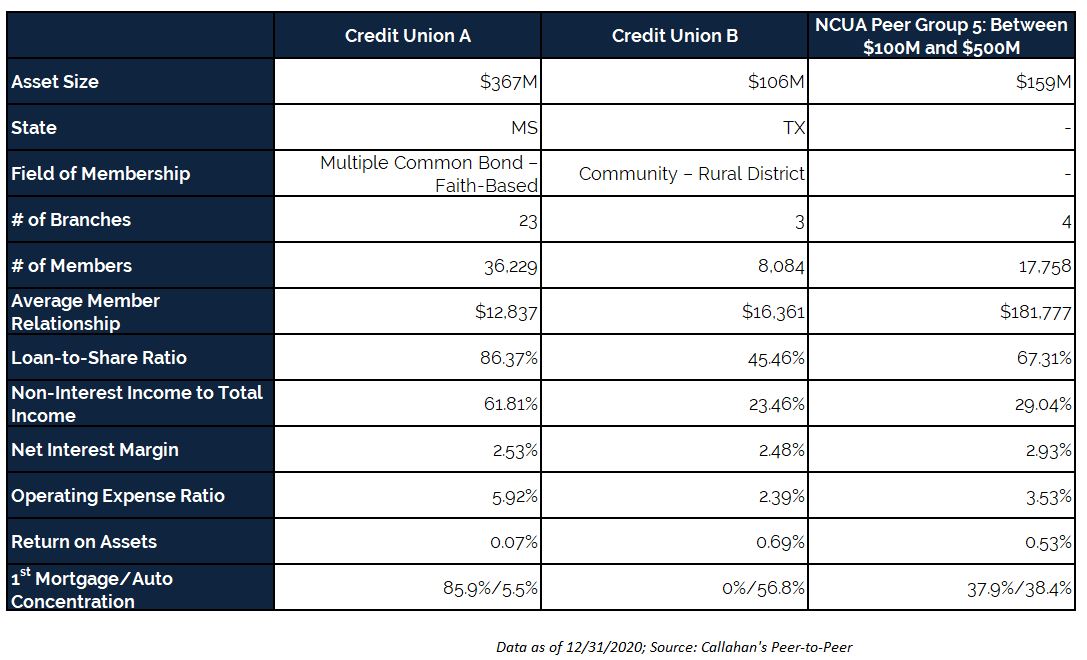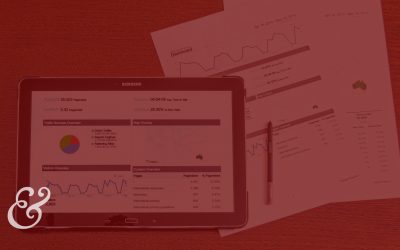While benchmarking your performance against asset-based peer groups has value, relying strictly on asset size for peer group analysis can skew your benchmarks by including credit unions that don’t share much in common with your institution.
Just take a look at this actual example of two credit unions within the same NCUA-designated peer group:

As the table shows, these credit unions are not an ideal comparison for each other even though they are included in and impact the numbers of the same peer group. For more accurate benchmarks against which to measure your credit union’s performance, try using the criteria below in addition to asset size.
Three Peer Group Ideas That Go Beyond Asset Size
Business Model
Credit union financials and operations can differ greatly based on the business model. For instance, non-interest income makes up 61% of credit union A’s total income while it comprises less than 25% of the total income of Credit Union B’s. This not only signifies a difference in how these credit unions generate revenue but also impacts key financial performance ratios like net interest margin and ROA
Loan Concentration
Loan concentration and production show where a credit union’s lending activities are most active and how it generates loan interest income. For example, Credit Union A’s loan composition is made up of 85.9% 1st mortgage loans while Credit Union B does not offer mortgage products and more than 56% of its loans are for new and used autos. Loan mixtures and concentration data help show an institution’s business focus and internal goals, letting you create peer groups of credit unions that are similar to yours in terms of strategy and operations.
Geography
Market dynamics, economic situations, and competition levels differ among geographic regions, states, and even counties. Considering geography is vital as location often impacts members’ demand for financial products, financial capacity, and lives in general. Members in Mississippi may have a different set of wants and needs than those in Texas.
Benchmark Your Credit Union’s Performance
Callahan’s data and analytics tools, Peer-to-Peer and CUAnalyzer, make it easy to build custom peer groups using the data and strategies listed above and more. With hundreds of pre-built formulas, graphs, and tables it’s easy to compare your credit union directly to relevant credit unions and banks.
Callahan clients can log in to the Callahan Portal to access their data and anlalytics tools.
Don’t have access? Click here to request a custom scorecard and we’ll show you how easy it is to build comparisons in Peer-to-Peer.
More Blogs
Most Downloaded Policy Exchange Documents Of 2020
There are more than 600 documents in Callahan’s Policy Exchange. Here are the top 10 most downloaded of 2020.
The Guide To A Purpose-Driven Organization
Download The Guide To A Purpose-Driven Organization and learn three steps credit unions can take to start the discussion of purpose at their organization.
10 Chart-Topping Credit Unions in Member Value
In honor of International Credit Union Day, Callahan spotlights credit unions of all sizes that return the most value to members.
How To Leverage Data For Better Strategic Planning
Incorporating peer analysis is an ideal way to enhance the impact of planning for credit unions.
Leading With Purpose
Leading With Purpose is a tool to help credit unions realize the competitive advantages of being purpose-driven.
Fall Virtual Roundtables Are Here!
Explore our upcoming Virtual Roundtables for credit union executives and learn how to register and get involved.
Trends And Takeaways From 2Q20 Trendwatch
With second quarter data now available in Peer-to-Peer, COVID-19’s impact on industrywide metrics is more apparent.
Peer-to-Peer Updates And Enhancements
The COVID-19 crisis has had a sudden and significant impact on the industry’s bottom line and day-to-day operations.
5 Benchmarking Pitfalls To Avoid
Flaws in benchmarking can lead to inaccurate perceptions of your credit union’s performance.










